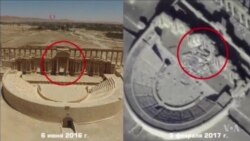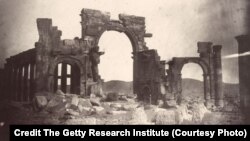The ancient Syrian city of Palmyra has captured the imagination of scholars and philosophers.
The United Nations Educational, Scientific and Cultural Organization (UNESCO) World Heritage Site has also been the target of the Islamic State terror group, which has destroyed parts of Palmyra.
“It makes you extremely sad, I mean furious, but also extremely sad to see something that stood since the Roman period not complete, but stood in this imposing monumentality, to see it just explode,” said Marilyn Buccellati, a researcher at the University of California, Los Angeles Cotsen Institute of Archeology.
“ISIS is ensconced in Palmyra. It was there in 2015. When it was there, it destroyed two of the major ruins that were standing -- the Temple of Bel and Baalshamin. Then they were pushed out by Syrian forces but then returned in 2016. And to the best of our knowledge, in early 2017 they went in and destroyed some of the other major standing ruins,” said Frances Terpak, Getty Research Institute curator.
An online exhibit by the Getty Research Institute in Los Angeles attempts to show the beauty of Palmyra before that destruction through photographs and etchings.
In a first online exhibition of the Institute, The Legacy of Ancient Palmyra shows the first photographs ever taken of this site in 1864 by Louis Vignes.There are also etchings from sketches made by architect Louis-François Cassas almost 100 years before the photos were taken.
“It’s amazing that in the 200 years since those prints and sketches how much had been lost, because those prints and sketches show completeness that it was really amazing,” Buccellati told VOA.
The desert city of Palmyra stretches some three kilometers and was at the crossroads of cultures and religions.
Since the mid-second to third century of the Common Era, Palmyra has been a gathering point of many cultures.
“They traded locally, but most importantly they also had a long distance trade that connected Asia with the Roman Empire silks and spices and goods going the other way too, from the West to the East. So, they were a multicultural and ethnic society that very much said something about us today and our whole mix of cultures and they lived together fairly peacefully,” said Terpak.
“So, you have a diversity in architecture, you have a diversity in the people that lived there. And another important thing, especially for early scholarship, was that there were so many inscriptions," said Getty Research Institute exhibition curator Peter Bonfitto. "So Palmyra had its own language. That was a form of Aramaic.”
“It was a relatively small site that really exploded in a few centuries and then was abandoned, so you have these incredible building projects going on,” Bonfitto added.
Palmyra has captured the imagination of archeologists and philosophers over the centuries.
“There’s French philosophers that picked up on Palmyra and used it as really a symbol for the end of civilizations. When the Roman Empire fell they look at Palmyra,” said Bonfitto.
Archeologist and historian at the UCLA Cotsen Institute of Archeology, Giorgio Buccellati, said places such as Palmyra speak to people across cultures.
“Everybody responds to beauty and Palmyra is a fantastic example of this -- the beauty of the buildings, the beauty of the objects, the beauty of the landscape also in which it is embedded,” Buccellati told VOA. ”You go back in time and you discover a different way in which -- different and yet the same response to reality that you have, so there is a sense of comfort almost in finding a similarity in the difference.”
Marilyn Buccellati remembered spending her second honeymoon at Palmyra with her husband, Giorgio Buccellati, some years ago.
“On a moonlit night, this is the romantic part, you can walk around this big, big courtyard of the Temple of Bel and appreciate the beauty of the antiquities,” described Buccellati.
The Temple of Bel has since been largely destroyed by Islamic State in 2015.
“Architecture is a record of not only the build environment, but of us as a people and how fragile actually it can be, reduced to dust in no time,” said Terpak.
The Getty Research Institute’s online exhibit through its photographs and etchings preserves what has been lost for the modern world.The exhibit will also be translated into Arabic to make this piece of history accessible to more people.







